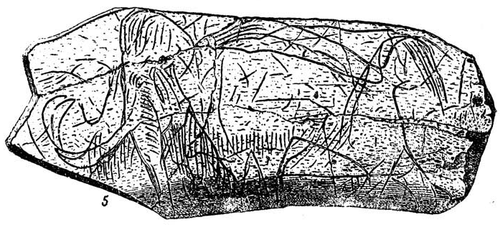Holly Oak Gorget
By Haley Allgeyer
In 1889, Hilborne T. Cresson announced that he had allegedly discovered the Holly Oak Gorget. He declared that the gorget was discovered by himself in 1864, at an archaeological site in northern Delaware [1]. The Holly Oak Gorget is a shell pendant, worn as a necklace, with a carving in it of what appears to by a woolly mammoth. The shell is made of busycon sinistrum, a sea snail, often found along the United States coast of the Atlantic Ocean.

History
Gorgets
A gorget or pendant is a sort of decorative necklace worn to display a person’s status. In Native American culture, it is common for a gorget to be carved out of materials such as shells, mollusks, gourds, etc. [3]. Different gorgets commonly show a person’s status within their tribe. Carvings can be related to family origins or tribe symbols. Because gorgets hold such great information about the tribe or owner who wore it, they are important archaeological finds. They can tell us many things about who wore the gorget, where it was carved, and the ancient community around the owner. In the example of the Holly Oak Gorget, if it were not fabricated, we could assume that the owner who wore the gorget encountered woolly mammoths, as that is what is carved into it.

La Madeleine
In 1864, Edouard Lartet discovered La Madeleine pendant which depicts a woolly mammoth carving, very similar to the Holly Oak carving Cite error: Closing </ref> missing for <ref> tag. This new publication directly opposes previous understandings of the artifact’s credibility, as well as the newer 1988 journal article, “A Mammoth Fraud in Science.”Kraft and Thomas brought multiple evidence into question in their article to examine the credibility. One example is the fact that early man could have actually lived within the late Pleistocene and early Holocene, making the carving possible as woolly mammoths and mastodons were present in North American during this time Cite error: Closing </ref> missing for <ref> tag. This background did help build his claim, though despite this, his “discovery” was never taken seriously by archaeologists. We know that Hilborne T. Cresson’s archaeological “discovery” was never taken seriously by reputable archaeologists, and it still is not today. One big reason for this is his personal and criminal history. In 1891, he was actually fired from the museum after being accused of stealing from archaeological sites [4]. We know that Hilborne T. Cresson’s archaeological “discovery” was never taken seriously by reputable archaeologists, and it still is not today. One big reason for this is his personal and criminal history. In 1891, he was actually fired from the museum after being accused of stealing from archaeological sites Cite error: Closing </ref> missing for <ref> tag.
Issues
The actual shell that the Holly Oak Gorget is carved from, is from Ohio, which is likely from when Cresson stole the gorget from Fort Ancient site as well. This type of shell is from the Ohio valley during the late Pleistocene period [5]. Not only is the shell very clearly not from northern Delaware, it also very closely resembles La Madeleine. This similarity is way too exact. They both depict a woolly mammoth carving in a very similar style. This evidence very obviously shows that the Holly Oak Gorget was based on La Madeleine. When the discovery of the Holly Oak Gorget was announced, Cresson claimed that he discovered the pendant in 1864, though he did not announce the discovery until 1889. This is very convenient, as he likely was aware that people would question the similarity between the two gorgets, so stating that he discovered it before La Madeleine would work perfectly for his claim.
References
- ↑ 2014 Gorgets Offer Insight Into Early Chickasaw Culture. IndianCountryToday.com. April 30.
- ↑ Images, Internet Archive Book 2015 Image from page 450 of "Annual report of the Board of Regents of the Smithsonian Institution" (1846). Flickr. Yahoo!, June 3
- ↑ The Holly Oak Pendant. Museum of Hoaxes.
- ↑ Griffin, James B., David J. Meltzer, Bruce D. Smith, and William C. Sturtevant 1988 A Mammoth Fraud in Science. American Antiquity 53(3): 578–582.
- ↑ Sturtevant, W. C., and D. J. Meltzer 1985 The Holly Oak Pendant. Science 227(4684): 242–244.